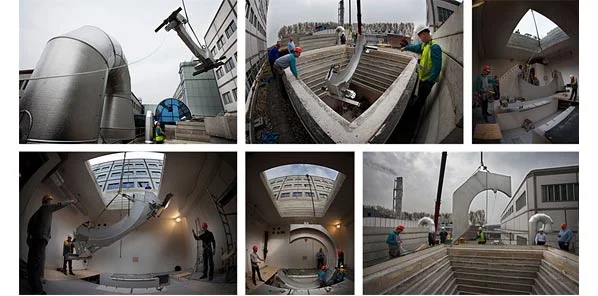First-generation system for testing at University Medical Center Utrecht is next step in what may be a quantum leap in tumour visualisation during radiotherapy
Royal Philips and The Netherlands’ University Medical Center (UMC) have announced that the initial components of the world’s first high-field magnetic resonance imaging (MRI) guided radiation therapy system are being installed at UMC Utrecht. This marks a significant milestone toward the development of a clinical system capable of capturing highly detailed MR images of tumours and surrounding normal tissues as a patient receives radiotherapy. Development of the high-field MRI-guided linear accelerator (linac) is the mission of the MR Linac Research Consortium headed by Elekta and supported by Philips.
The integration of an advanced Philips 1.5 Tesla MRI system with a sophisticated Elekta radiation therapy system – enabling simultaneous imaging during beam delivery – could allow doctors to adapt radiation therapy during the procedure, increasing treatment accuracy, potentially reducing side effects and enabling increases in the therapeutic dose.
On April 5, the first component – the system’s ring gantry on which linac parts are mounted – was lowered by crane through a modular roof into one of UMC Utrecht’s radiotherapy treatment rooms. In the coming months, additional components will be integrated and the system will undergo a program of non-clinical testing, which includes the performance evaluation of MRI sequences, testing of different adaptive delivery methods, establishing quality assurance techniques and defining workflow.
“Since formation of the consortium in 2012, members have been exploring the feasibility of high-field MRI-guided radiotherapy. Installation of the first generation system is truly a major step toward moving this technology into the clinic to benefit patients,” says Bas Raaymakers, PhD, Associate Professor, Department of Radiotherapy, UMC Utrecht. “We’re immensely proud of the critical role that UMC Utrecht has played in collaboration with Philips and Elekta in this project for over 10 years.”
“As the founding member of the consortium, UMC Utrecht has been instrumental in turning the concept of MRI guided radiation therapy into a working system, and has invested a great deal of effort and resources to make it a reality,” adds Tomas Puusepp, President and CEO, Elekta. “We are excited about the prospect of taking high-field MRI-guided radiation therapy to the next stage.”
“Highly targeted treatments will be essential in the battle to control cancer, so together with our partners we are stepping up our efforts to create new solutions in interventional oncology,” says Gene Saragnese, CEO Imaging Systems at Philips Healthcare. “The installation of the first generation MR-guided radiation system at UMC Utrecht is an important milestone in the development of an innovation that is designed to make a real difference in cancer care.”
In addition to UMC Utrecht, the other consortium members are: The University of Texas MD Anderson Cancer Center (Houston, Texas), The Netherlands Cancer Institute-Antoni van Leeuwenhoek Hospital (Amsterdam, the Netherlands), Sunnybrook Health Sciences Centre (Toronto, Ontario) and The Froedtert & Medical College of Wisconsin Cancer Center (Milwaukee, Wisconsin).
Source: Philips
8 April 2014
Latest Articles
Imaging, MRI, Philips, Radiation, Oncology, treatment, cancer treatment, radiation therapy
First-generation system for testing at University Medical Center Utrecht is next step in what may be a quantum leap in tumour visualisation during radiothe...










